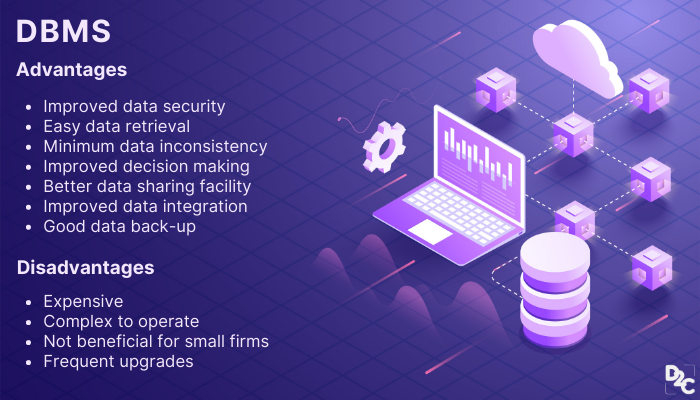Database Management System (DBMS)
• Collection of interrelated data
• Set of programs to access the data
• DBMS contains information about a particular enterprise
• DBMS provides an environment that is both convenient and efficient to use.
• Database Applications: • Banking: all transactions
• Airlines: reservations, schedules
• Universities: registration, grades
• Sales: customers, products, purchases
• Manufacturing: production, inventory, orders, supply chain
Difference between File System and DBMS
Data models - relational, hierarchical, network
1. Hierarchical Data Model:
Hierarchical data model is the oldest type of the data model. It was developed by IBM in 1968. It organizes data in the tree-like structure. Hierarchical model consists of the following :
- It contains nodes which are connected by branches.
- The topmost node is called the root node.
- If there are multiple nodes appear at the top level, then these can be called as root segments.
- Each node has exactly one parent.
- One parent may have many child.
It is the advance version of the hierarchical data model. To organize data it uses directed graphs instead of the tree-structure. In this child can have more than one parent. It uses the concept of the two data structures i.e. Records and Sets.
3. Relational Data Model:
The relational data model was developed by E.F. Codd in 1970. There are no physical links as they are in the hierarchical data model. Following are the properties of the relational data model :
- Data is represented in the form of table only.
- It deals only with the data not with the physical structure.
- It provides information regarding metadata.
- At the intersection of row and column there will be only one value for the tuple.
- It provides a way to handle the queries with ease.
Difference between Hierarchical, Network and Relational Data Model:
| S. No. | Hierarchical Data Model | Network Data Model | Relational Data Model |
|---|---|---|---|
| 1. | In this model, to store data hierarchy method is used. It is the oldest method and not in use today. | It organizes records to one another through links or pointers. | It organizes records in the form of table and relationship between tables are set using common fields. |
| 2. | To organize records, it uses tree structure. | It organizes records in the form of directed graphs. | It organizes records in the form of tables. |
| 3. | It implements 1:1 and 1:n relations. | In addition to 1:1 and 1:n it also implements many to many relationships. | In addition to 1:1 and 1:n it also implements many to many relationships. |
| 4. | Pointers are used to establish relationships among records physically. | A linked list is used to establish a relationship among records physically. | The logical representation is used with rows and columns to depict relationship among records. |
| 5. | Insertion anomaly exits in this model i.e. child node cannot be inserted without the parent node. | There is no insertion anomaly. | There is no insertion anomaly. |
Physical level – it will contains block of storages (bytes,GB,TB,etc)
Logical level – it will contain the fields and the attributes of data.
View level – it works with CLI or GUI access of database
Data Independence
Structure of DBMS
Database Users
• Users are differentiated by the way they expect to interact with the system
• Application programmers – interact with system through DML calls
• Sophisticated users – form requests in a database query language
• Specialized users – write specialized database applications that do not fit into the traditional data processing framework
• Naïve users – invoke one of the permanent application programs that have been written previously
• E.g. people accessing database over the web, bank tellers, clerical staff
.png)

.png)

Comments
Post a Comment